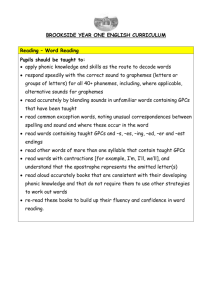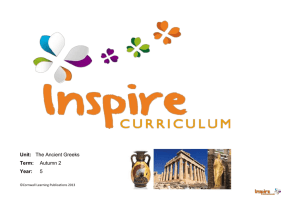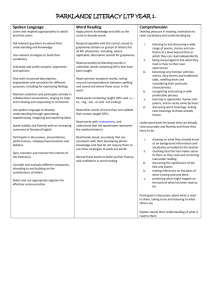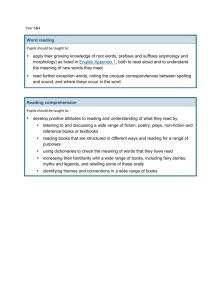Why are Humans Animals Too
advertisement
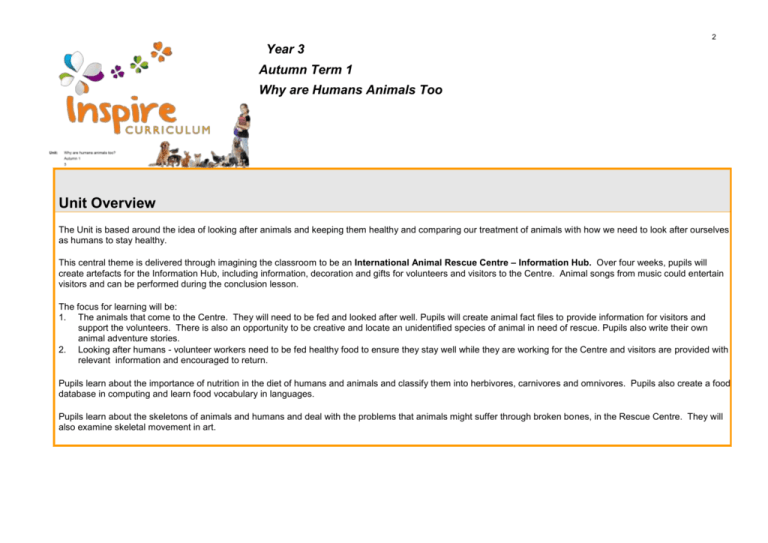
2 Year 3 Autumn Term 1 Why are Humans Animals Too Unit Overview The Unit is based around the idea of looking after animals and keeping them healthy and comparing our treatment of animals with how we need to look after ourselves as humans to stay healthy. This central theme is delivered through imagining the classroom to be an International Animal Rescue Centre – Information Hub. Over four weeks, pupils will create artefacts for the Information Hub, including information, decoration and gifts for volunteers and visitors to the Centre. Animal songs from music could entertain visitors and can be performed during the conclusion lesson. The focus for learning will be: 1. The animals that come to the Centre. They will need to be fed and looked after well. Pupils will create animal fact files to provide information for visitors and support the volunteers. There is also an opportunity to be creative and locate an unidentified species of animal in need of rescue. Pupils also write their own animal adventure stories. 2. Looking after humans - volunteer workers need to be fed healthy food to ensure they stay well while they are working for the Centre and visitors are provided with relevant information and encouraged to return. Pupils learn about the importance of nutrition in the diet of humans and animals and classify them into herbivores, carnivores and omnivores. Pupils also create a food database in computing and learn food vocabulary in languages. Pupils learn about the skeletons of animals and humans and deal with the problems that animals might suffer through broken bones, in the Rescue Centre. They will also examine skeletal movement in art. Unit: Why are humans animals too? Year: 3 Term: Autumn 1 Key: FT = First Teaching OG = On Going Please note that all appendices and guidelines referred to in the programme of study are available to download at: https://www.gov.uk/government/collections/national-curriculum The POS codes replace the DfE bullets for ease of reference. Spoken Language SL1 listen and respond appropriately to adults and their peers SL2 ask relevant questions to extend their understanding and knowledge SL3 use relevant strategies to build their vocabulary SL4 articulate and justify answers, arguments and opinions SL5 give well-structured descriptions, explanations and narratives for different purposes, including for expressing feelings SL6 maintain attention and participate actively in collaborative conversations, staying on topic and initiating and responding to comments SL7 use spoken language to develop understanding through speculating, hypothesising, imagining and exploring ideas SL8 speak audibly and fluently with an increasing command of Standard English SL9 participate in discussions, presentations, performances, role play, improvisations and debates SL10 gain, maintain and monitor the interest of the listener(s) SL11 consider and evaluate different viewpoints, attending to and building on the contributions of others SL12 select and use appropriate registers for effective communication These statements apply to all Years. The content should be taught as a level appropriate to the age of the pupils (taken from notes and guidance [nonstatutory]). Speaking and listening activities throughout the Unit have been designed with these POS statements in mind. Specific speaking and listening objectives are provided for some English lessons where appropriate. Reading – word reading WR1 apply their growing knowledge of root words, prefixes and suffixes (etymology and morphology) as listed in English Appendix 1, both to read aloud and to understand the meaning of new words they meet FT Reading – comprehension RC1 develop positive attitudes to reading and understanding of what they read by: RC1.1 listening to and discussing a wide range of fiction, poetry, plays, non-fiction and reference books or textbooks FT RC1.7 discussing words and phrases that capture the reader’s interest and imagination FT RC2 understand what they read, in books they can read independently, by: RC2.1 checking that the text makes sense to them, discussing their understanding and explaining the meaning of words in context FT RC2.4 predicting what might happen from details stated and implied FT RC2.6 identifying how language, structure, and presentation contribute to meaning FT RC3 retrieve and record information from non-fiction FT Writing – transcription – spelling – SCHOOLS TO USE SPELLING PROGRAMME WTS1 use further prefixes and suffixes and understand how to add them (English Appendix 1) FT WTS2 spell further homophones FT WTS3 spell words that are often misspelt FT WTS5 use the first two or three letters of a word to check its spelling in a dictionary FT WTS6 write from memory simple sentences, dictated by the teacher, that include words and punctuation taught so far FT Writing – handwriting WH1 use the diagonal and horizontal strokes that are needed to join letters and understand which letters, when adjacent to one another, are best left unjoined FT WH2 increase the legibility, consistency and quality of their handwriting, e.g. by ensuring that the downstrokes of letters are parallel and equidistant; that lines of writing are spaced sufficiently so that the ascenders and descenders of letters do not touch FT Writing – composition WC1 plan their writing by: WC1.1 discussing writing similar to that which they are planning to write in order to understand and learn from its structure, vocabulary and grammar FT WC1.2 discussing and recording ideas FT WC2 draft and write by: WC2.1 composing and rehearsing sentences orally (including dialogue), progressively building a varied and rich vocabulary and an increasing range of sentence structures (See English Appendix 2) FT WC2.4 in non-narrative material, using simple organisational devices (for example as headings and sub-headings FT Writing – vocabulary, grammar and punctuation WVGP1 develop their understanding of the concepts set out in Appendix 2 by: WVGP1.1 extending the range of sentences with more than one clause by using a wider range of conjunctions, e.g. when, if, because, although FT WVGP1.4 using conjunctions, adverbs and prepositions to express time and cause FT WVGP1.6 learning the grammar for years 3 and 4 in English Appendix 2 FT WVGP2 indicate grammatical and other features by: WVGP2.3 using and punctuating direct speech THROUGH NARRATIVE FT WVGP3 use and understand the grammatical terminology in English Appendix 2 accurately and appropriately when discussing their writing and reading FT Number – number and place value 1 count from 0 in multiples of 4, 8, 50 and 100; finding 10 or 100 more or less than a given number 2 recognise the place value of each digit in a three-digit number (hundreds, tens, ones) 3 compare and order numbers up to 1000 4 identify, represent and estimate numbers using different representations 5 read and write numbers to at least 1000 in numerals and in words 6 solve number problems and practical problems involving these ideas Number – addition and subtraction 1 add and subtract numbers mentally, including: 1.1 a three-digit number and ones 1.2 a three-digit number and tens 1.3 a three-digit number and hundreds 2 add and subtract numbers with up to three digits, using formal written methods of columnar addition and subtraction 3 estimate the answer to a calculation and use inverse operations to check answers 4 solve problems, including missing number problems, using number facts, place value, and more complex addition and subtraction Measurement 4 tell and write the time from an analogue clock, including using Roman numerals from I to XII, and 12-hour and 24-hour clocks and 12hour and 24-hour clocks 5 estimate and read time with increasing accuracy to the nearest minute; record and compare time in terms of seconds, minutes and hours; use vocabulary such as o’clock, a.m./p.m., morning, afternoon, noon and midnight 6 know the number of seconds in a minute and the number of days in each month, year and leap year 7 compare durations of events (for example to calculate the time taken by particular events or tasks) Working scientifically 1 asking relevant questions and using different types of scientific enquiries to answer them 2 setting up simple practical enquiries, comparative and fair tests 3 making systematic and careful observations and, where appropriate, taking accurate measurements using standard units, using a range of equipment thermometers and data loggers 4 gathering, recording, classifying and presenting data in a variety of ways to help in answering questions 5 recording findings using simple scientific language, drawings, labelled diagrams, bar charts, and tables 6 reporting on findings from enquiries, including oral and written explanations, displays or presentations of results and conclusions 7 using results to draw simple conclusions, make predictions for new values, suggest improvements and raise further questions 8 identifying differences, similarities or changes related to simple scientific ideas and processes 9 using straightforward scientific evidence to answer questions or to support their findings Animals including humans 1 identify that animals, including humans, need the right types and amount of nutrition, and that they cannot make their own food; they get nutrition from what they eat 2 identify that humans and some animals have skeletons and muscles for support, protection and movement 1 play and perform in solo and ensemble contexts, using their voice and playing musical instruments with increasing accuracy, control and expression 3 listen with attention to detail and recall sounds with increasing aural memory 1 to create sketch books to record their observations and use them to review and revisit ideas 5 use search technologies effectively, appreciate how results are selected and ranked, and be discerning in evaluating digital content 6 select, use and combine a variety of software (including internet services) on a range of digital devices to accomplish given goals, including collecting, analysing, evaluating and presenting data and information 7 use technology safely, respectfully and responsibly; recognise acceptable/unacceptable behaviour; identify a range of ways to report concerns about content and contact 1 listen attentively to spoken language and show understanding by joining in and responding 2 explore the patterns and sounds of language through songs and rhymes and link the spelling, sound and meaning of words 3 engage in conversations; ask and answer questions; express opinions and respond to those of others; seek clarification and help* 4 speak in sentences, using familiar vocabulary, phrases and basic language structures develop accurate pronunciation and intonation so that others understand when they are reading aloud or using familiar words and phrases* 5 7 read carefully and show understanding of words, phrases and simple writing 8 appreciate stories, songs, poems and rhymes in the language 9 broaden their vocabulary and develop their ability to understand new words that are introduced into familiar written material, including through using a dictionary 12 understand basic grammar appropriate to the language being studied, such as (where relevant): feminine, masculine and neuter forms and the conjugation of high-frequency verbs; key features and patterns of the language; how to apply these, for instance, to build sentences; and how these differ from or are similar to English. The starred (*) content above will not be applicable to ancient languages.
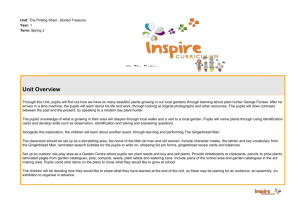
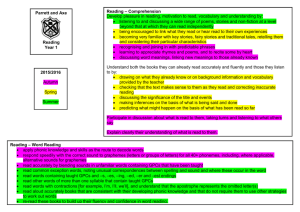

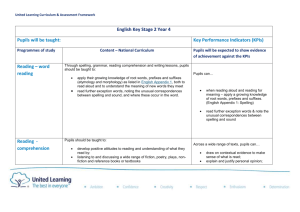
![afl_mat[1]](http://s2.studylib.net/store/data/005387843_1-8371eaaba182de7da429cb4369cd28fc-300x300.png)

